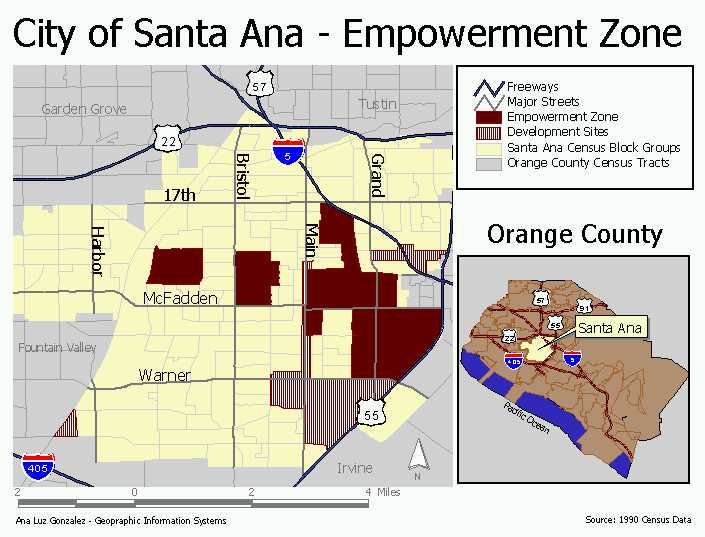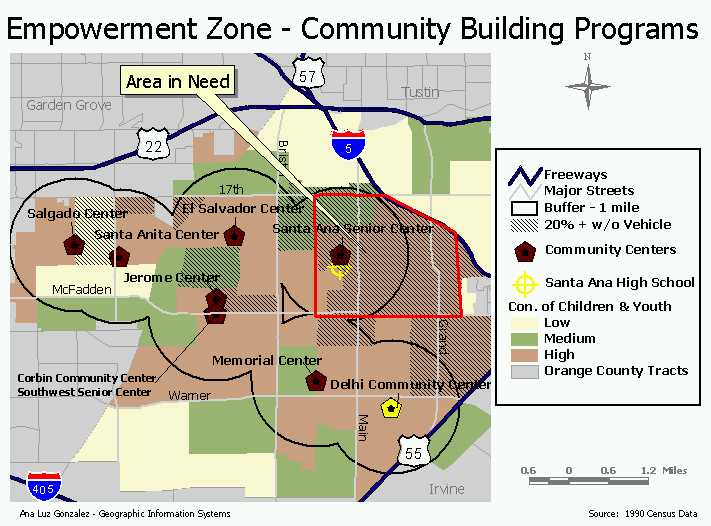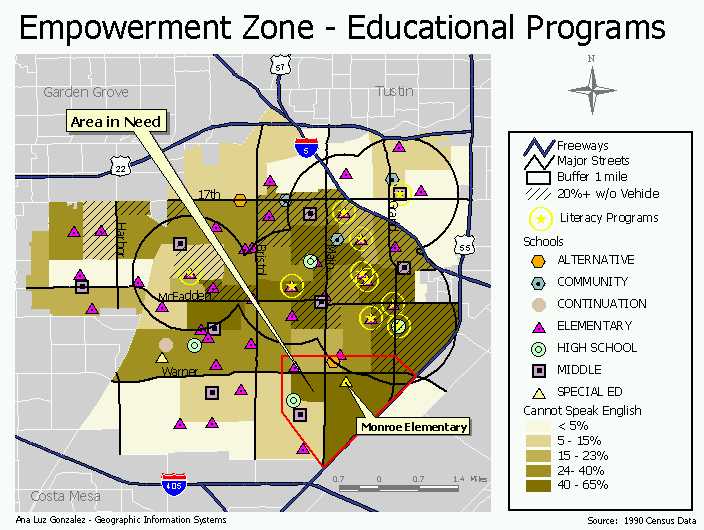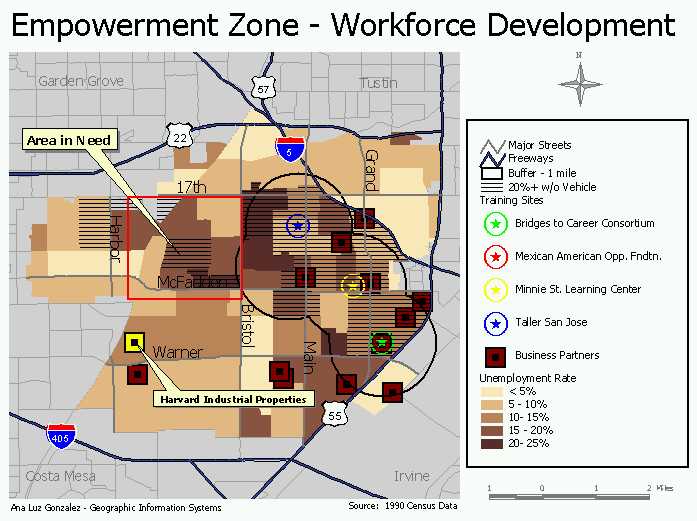Figure 1

The City
of Santa Ana's Empowerment Zone:
Funding
Recommendations for 2001-02
“…The Empowerment Zone is another
tool to maximize and leverage out resources through community partnerships.
Together with our residents we
are building up our city, block by block”
Mayor Miguel Pulido
Introduction
In June of 1999, the U.S. Department of Urban Development Secretary Andrew Cuomo delivered a three million dollar grant to the City of Santa Ana, to begin implementing its plan for a new Empowerment Zone1 aimed at helping the poorest areas in the city2. Like many cities across America, Santa Ana faces complex challenges while searching to provide a better quality of life. In efforts to revitalize the social, economic, and cultural fabric of its community, the City of Santa Ana decided to focus on three major areas: Education, Business Development and Job Training and Placement. Education and job training will provide Santa Ana residents with the knowledge and skills to become productive members of the community. Business activities will facilitate job creation and promote linkages between residents and local businesses3. By focusing in areas that promote opportunities for social and economic growth, Santa Ana will be better equipped to lead its residents into the 21st century.
In January of 2000, the City of Santa Ana received much more – $100 million in federal grants to be disbursed over the next 10 years. The City of Santa Ana will focus on providing services in 10 general areas: 1) Community Building, 2) Workforce Empowerment, 3) Business Development, 4) Transportation, 5) Health, 6) Childcare, 7) Arts & Culture, 8) Education, 9) Safety, and 10) Housing. The federal investment is expected to stimulate more than $2.5 billion in additional private and public sector investment, and create or retain 1,000 jobs.
Purpose
I will be focusing on services provided by the Empowerment Zone during two funding periods 1999-2000 and 2000-2001. The purpose of this analysis is twofold: to identify areas in need of services and to provide recommendations for future project implementation. This analysis will further explore existing services to analyze whether or not services are located in the appropriate areas. I will concentrate on four major areas: Health, Workforce Development, Education, and Community Building. By mapping service provided by the Empowerment Zone a better assessment can be made on whether the services funded are in the areas where their use can be maximized. It also provides great insight into where services are needed.
Area of Study
The City of Santa Ana, located in the center of Orange County, covers 27.2 square miles and has a population of over 311,000. As seen in Figure 1, Santa Ana is served by five freeways including the Santa Ana Freeway (I-5), the Garden Grove Freeway (SR-22), the Costa Mesa Freeway (SR-55), the San Diego Freeway (I-405), and the Orange Freeway, (SR-57). As the fifth largest city in Orange County, Santa Ana is quickly running scarce of vacant land, therefore a large majority of new development involves the redevelopment of previously improved land. The Empowerment Zone was designated to revitalize the most impoverished areas in Santa Ana.
Figure 1

As seen in Table 1, Santa Ana's Empowerment Zone encompasses the poorest and most under served areas in the city. The Empowerment Zone has an unemployment rate twice as high as the rest of Orange County and 1 out of 3 Empowerment Zone families are living in poverty. As of 1990, the median family income in the Empowerment Zone communities was $16,827 -- less than half of Santa Ana's median family income of $35,939. The Hispanic population within the City of Santa Ana is 69 percent, while in the Empowerment Zone communities it is 88 percent4.
Table 1: Empowerment Zone Statistics*
| Zone Population: |
|
| Approximate Zone Size: |
|
| Unemployment Rate: |
|
| Education: | 20% of the Zone residents, 18 to 25 years of age have high school diplomas |
| Population: |
|
| Poverty Rate: |
|
| Other characteristics: |
|
|
|
|
|
|
Analysis
The following maps utilize demographic information to asses whether funding programs are located in the appropriate areas. I chose to focus on four areas: Community Building, Education, Health, and Workforce Development. Information was gathered from four sources: the the City of Santa Ana's Economic Development Department, the city's web page, internet searches and interviews. Phone calls were also made to various agencies to better understand the degree of services rendered. All data is based on the 1990 Census obtained through the ESRI website.
I have analyzed each of the four areas - Community Building, Education, Health, and Workforce Development - separately and have added the information of each program funded for that specific area. Below is a description of my findings as well as recommendations for future project implementation.
Community Building
Objective: Establish the
Empower Santa Ana Corporation (ESAC) Executive Director's office to provide
continual coordination of
committees, oversight of performance measurements, and ongoing outreach
to Empowerment Stakeholders5.
An implementation plan was designed to continue providing high levels of recreational services and create new opportunities for open space and community center development. Santa Ana has the youngest median age of any city in the United States at 26.1 years. As seen in Figure 2, there is a large concentration of children and youth6 in the center of the city. Santa Ana houses six community centers and two senior centers. The Empowerment Zone provided funding for Delhi Community Center to open its doors in January 2000. This was the only project for Community Building for both funding periods (99-00 and 00-01).
All community centers are located where there is an evident concentration of children and youth. Community centers offer an array of services from childcare to job training, but their primary focus is to provide youth a place that is safe and where they can learn. I focused on children and youth because these facilities are primarily used by this population. I also wanted to know if access would be a problem. Therefore by mapping household without a car I was able to locate the area with the most dire need of a community center.
As seen in Figure 2, the area in need of a community center is located right next to the freeway designated by the red polygon. This area is also considered part the Empowerment Zone. The Santa Ana Senior Center is located in the middle of the designated area in need, but it provides services primarily for senior citizens.
Figure 2

The following recommendations were based on the information provided by Figure 1 and on an observational assessment of the area.
* Utilize area southwest of Santa Ana High School to build a community center- This area is currently occupied and is used as a parking lot. It houses several bungalows, but its location is key in providing the services needed in this area.* Recruit high school students as volunteers - Students will serve as a great resource to keep the area clean and full of ongoing
*
Provide
jobs for residents and students - A new community center will not only
help youth find a safe place to interact, but it will
also
bring a greater sense of community to the neighborhood. Students
and residents can find employment near their home and the
community
center could be used to provide job training, childcare, and other needed
services.
Educational Programs
Objective: Provide educational
opportunities for adults disadvantaged by language barriers, by providing
Spanish and
English literacy classes and increasing
the availability of libraries and relevant materials7.
The City of Santa Ana's motto "Education First" sets the basis for the community's commitment towards educating its youth. Santa Ana strategies for education focuses in four areas: Stay in School, School/Business Partnerships, Adult Education/Literacy, and College/Higher Education. I focused on the literacy programs8 funded by the Empowerment Zone because of the astounding number of residents who cannot speak English. I also mapped household without a vehicle because access is as important as the services being provided.
As seen in Figure 3, the literacy programs were located in the areas with high need. Eight of the literacy programs took place in elementary schools, one in a middle school, while the remainder was hosted at a high school. The area in need as designated by the red polygon was derived by analyzing what area had a high percentage of individuals who do not speak English and by looking at which area had not yet been serviced.
Figure 3

The following recommendations are for funding a new literacy program.
* Provide funding to Monroe Elementary to begin a Literacy Program - Monroe Elementary is located in a prime location where there is a high percentage of individuals who cannot speak English.* Provide evening classes to teach English Language Development (ELD) and courses needed to obtain a GED - residents will be able
*
Provide
an after school program for students that promotes literacy and encourages
parent participation - Create programs that
are
appealing for both students and parents in which both can interact
and learn.
Health Programs
Objective: Create a community health network that will provide knowledge and accessible health care to those residents in need9.
Health is an important issue in a city with such a young population. The goal of the Empowerment Zone Health Programs is "to make health care accessible to all residents in the Empowerment Zone by increasing their knowledge, resources, and control in the decisoin-making process about their health and their community10". Considering that many residents in the Empowerment Zone are living in poverty, where services are provided and access to these services is crucial for a healthy community to begin to emerge.
As seen in Figure 4, the area in desperate need of health services is located between Bristol and Harbor Street, designated by the yellow square. The area in need not only has a high percentage of households living in public assistance, but it also has a high percentage of households without a vehicle. The lack of health facilities in this area poses a greater urgency to provide services not only for those in the Empowerment Zone but for all residents.
Figure 4

The following are recommendations based on Figure 4 and per a conversation with an employee at El Salvador Community Center.
* Provide funding to El Salvador Center - El Salvador Center is located adjacent to the area in need and currently it only provides health services twice a month.* Provide evening classes to increase knowledge of health care resources and to teach how to maintain a healthy standard of living -
*
Create
partnerships with neighboring health facilities. Partnerships with
Santa Ana Hospital Medical Center, St. Edna Subacute
and
Rehabilitation Center, and County of Orange Home Health Care Agency can
be established to strengthen the services
provided
by the Empowerment Zone.
Workforce Development
Objective: Improve access to capital and entrepreneurial assistance by leveraging of resources11.
Santa Ana has a well established and successful business outreach program, which emphasizes utilization of its award winning state Enterprise Zone program's tax incentives in conjunction with other available resources (1998 AAEX/NASDA national award under category of 'federal WX.EC eligible community," and several state Zone Excellence awards, including "Most Innovative (Hiring Credit) Vouchering System")12.
Being that Santa Ana's unemployment rate is twice as high as that of the County, a more aggressive plan was implemented to train individuals to go out into the workforce. As seen in Figure 5, the areas with high percentages of unemployment are scattered throughout the city. The area in need, designated by the red square, was derived by considering two factors; unemployment rate and households without a vehicle. In both cases the unemployment rate and percentage of households without a vehicle is higher than 20 percent.
Figure 5

The following are recommendations for new training sites.
*
Create
partnerships with neighboring businesses. Partnerships can be established
with Harvard Industrial Properties and
other
businesses to strengthen the training programs provided by the Empowerment
Zone.
* Provide free buss passes for those who do not have a reliable means of transportation.
*
Increase outreach efforts for both businesses and residents.
Conclusion
In conclusion, this analysis is the beginning of a more comprehensive assessment of community needs and services provided by the Empowerment Zone. Santa Ana's strategic plan to revitalize the most distressed communities could become a prime model to showcase how partnerships between government and the people it serves can be successful. This is only the second year of funding and with a clear method of checks and balances the City of Santa Ana has the economic vigor, social and political capacity to become a model city and lead its residents to the 21st century and beyond.
Limitations
Due to time constraints I was unable to receive information for all programs funded by the Empowerment Zone in years 1 and 2. I chose the areas of need primarily based on census data and any other available information. The Census data is also 10 years old, which may or may not depict how the city is now.
A more thorough investigation can be made by conducting
a needs assessment of the communities in question and by interviewing the
organizations for which funding was received.
Ana Luz Gonzalez
Final Project
UP 206A
anagonza@ucla.edu
1. On December 21, 1994, President Clinton and Vice President Gore established an initiative that would dramatically improve the landscapes of many impoverished American communities. They designated 105 distressed communities across the Nation as Empowerment Zones and Enterprise Communities (EZs and ECs) through the EZ/EC Initiative. In January 1999, the initiative was expanded through a second round of designations to include Cincinnati as one of 20 new urban and rural Empowerment Zones and 20 new rural Enterprise Communities. Since the inception of the program, the EZ/EC Initiative has been a catalyst for change, improving the lives of thousands of people in America's most distressed rural and urban areas.
2. Source: www.hud.gov/pressrel/pr99-105.html.
3. Source: www.ci.santa-ana.ca.us/departments/cda/empowerment.
4. Source: www.ci.santa-ana.ca.us/departments/cda/empowerment/exec.html.
5. Source: Ibid.
6. The percentage for children and youth was derived by adding the fields - AGE05_09 + AGE10_14 + AGE15_19/persons. Graduated color was used to show the levels of concentration.
7. Source: www.ci.santa-ana.ca.us/departments/cda/empowerment/11_strategies.html. This is one of 4 objectives.
8. The literacy programs mapped were those funded in 2000-01. Literacy programs funded by the Empowerment Zone for 1990-00 were not available.
9. Source: www.ci.santa-ana.ca.us/departments/cda/empowerment/11_strategies.html. This is one of 3 objectives. The health programs mapped were those funded for 1999-00 and 2000-01.
10. Source: www.ci.santa-ana.ca.us/departments/cda/empowerment/exec.html. The health programs mapped were those funded for 1999-00 and 2000-01.
11. Source: www.ci.santa-ana.ca.us/departments/cda/empowerment/11_strategies.html. This is one of 3 objectives.
12. Source: www.ci.santa-ana.ca.us/departments/cda/empowerment/exec.html.